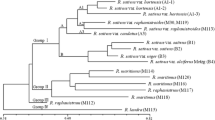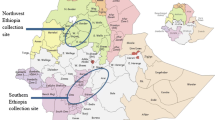Abstract
Seventy-three breeding lines and cultivars, which included all Japanese cultivars, were assessed by random amplified polymorphic DNA (RAPD) analysis. Thirty-one of 40 decamer primers revealed 84 scorable RAPDs. Using these RAPDs, 67 of 73 cultivars were distinguished from each other. One of the cultivars released as a protoclonal variant was able to distinguish from the parent by increasing the number of primers surveyed. Based on the number of different RAPDs between each pair of accessions, cluster analysis was performed to exploit genetic diversity in Japanese cultivars. Closely related cultivars deduced from their pedigrees were clustered closely, indicating that similarities based on the presence vs. absence of RAPDs were reflections of genetic similarities. Old Japanese cultivars, as suggested by their similarity of chloroplast DNA toS. tuberosum ssp.andigena, were indeed clustered with ssp.andigena accessions, supporting these were relic cultivars of early European potatoes. The present study suggests that Japanese potatoes are an interesting mass of genetic diversity including North American, European, and Andean germplasms and relic potatoes.
Compendio
Setenta y tres líneas de mejoramiento y cultivares, que incluyen a todos los cultivares japoneses, fueron determinados por el análisis del DNA polimórfico amplificado al azar (RAPD). Treinta y uno de 40 imprimadores decameros revelaron 84 RAPDs posibles de marcar. Utilizando estos RAPDs, 67 de 73 cultivares fueron distinguidos unos de los otros. Uno de los cultivares liberados como una variante protoclonal fue distinguido del progenitor incrementando el numéro de imprimadores estudiados. Basándose en el numéro de diferentes RAPDs entre cada par de entradas, se llevó a cabo un análisis de grupos para aprovechar la diversidad genética en los cultivares japoneses. Los cultivares muy relacionados a juzgar por sus genealogías se encontraban bien agrupados, indicando que las similitudes basadas en la presencia o ausencia de RAPDs eran un reflejo de las similitudes genéticas. Los viejos cultivares japoneses, a juzgar por la similitud del DNA de sus cloroplastos a S. tuberosum ssp. andigena, estaban de hecho agrupados con las entradas de la ssp. andigena, apoyadas por los viejos cultivares de las primeras papas europeas. Este estudio sugiere que las papas japonesas son una masa imteresante de diversidad genética incluyendo germoplasmas norteamericanos, europeos y andinos, y papas muy antiguas.
Similar content being viewed by others
Literature Cited
Demeke, T., L.M. Kawchuk and D.R. Lynch. 1993. Identification of potato cultivars and clonal variants by random amplified polymorphic DNA analysis. Am Potato J 70: 561–570.
Douches, D.S., K. Ludlam and R. Freyre. 1991. Isozyme and plastid DNA assessment of pedigrees of nineteenth century potato cultivars. Theor Appl Genet 82: 195–200.
Doyle, J.J. and J.L. Doyle. 1987. A rapid DNA isolation procedure for small quantities of fresh leaf tissue. Phytochem Bull 19: 11–15.
Dweikat, I., S. Mackenzie, M. Levy and H. Ohm. 1993. Pedigree assessment using RAPDDGGE in cereal crop species. Theor Appl Genet 85: 497–505.
Fukuoka, S., K. Hosaka and O. Kamijima. 1992. Use of random amplified polymorphic DNAs (RAPDs) for identification of rice accessions. Jpn J Genet 67: 243–252.
Hawkes, J.G. 1956. Taxonomic studies on the tuber-bearing Solanums. 1.Solanum tuberosum and the tetraploid complex. Proc Linn Soc London 166: 97–144.
Hosaka, K. 1993. Similar introduction and incorporation of potato chloroplast DNA in Japan and Europe. Jpn J Genet 68: 55–61.
Hosaka, K. and R.E. Hanneman, Jr. 1988. The origin of the cultivated tetraploid potato based on chloroplast DNA. Theor Appl Genet 76: 172–176.
Hosaka, K. and K. Ogawa. 1994. Genetic diversity in Japanese and North American potato cultivars evaluated by RAPD analysis. Sci Rept Fac Agr Kobe Univ 21: 39–42.
Hosaka, K. and R.E. Hanneman, Jr. (1994). Random amplified polymorphic DNA markers detected in a segregating hybrid population ofSolanum chacoense ×S. phureja. Jpn J Genet 69: 53–66.
Hu, J. and C.F. Quiros. 1991. Identification of broccoli and cauliflower cultivars with RAPD markers. Plant Cell Rep 10: 505–511.
Irikura, Y. 1968. Studies on interspecific crosses of tuber-bearingSolanums. 1. Overcoming cross-incompatibility betweenSolanum tuberosum and otherSolanum species by mean of induced polyploids and haploids. Bull Hokkaido Natl Agr Exp Stn 92: 21–37.
Joshi, C.P. and H. Nguyen. 1993. Application of the random amplified polymorphic DNA technique for the detection of polymorphism among wild and cultivated tetraploid wheats. Genome 36: 602–609.
Koller, B., J.M. Lehmann, J.M. McDermott and C. Gessler. 1993. Identification of apple cultivars using RAPD markers. Theor Appl Genet 85: 901–904.
Kresovich, S., J.G.K. Williams, J.R. McFerson, E.J. Routman and B.A. Schaal. 1992. Characterization of genetic identities and relationships ofBrassica oleracea L. via a random amplified polymorphic DNA assay. Theor Appl Genet 85: 190–196.
Laufer, B. 1938. The American plant migration. Part 1: The potato. The potato in Japan and Korea. Anthropological Series, Field Museum of Natural History 28: 80–83.
Matsunaga, H. 1992. A new potato variety “Musamaru”. Nogyo Gijutsu 47: 556.
Mendoza, H.A. and F.L. Haynes. 1974. Genetic relationship among potato cultivars in the United States. HortScience 9: 328–330.
Mori, M. and Y. Umemura. 1992. Current situation of potato processing in Japan. JARQ 26: 157–164.
Mori, M. and Y. Umemura. 1992. Potato breeding for cyst nematode resistance.In: Progess in nematology — a commemoration of the twentieth anniversary of the Japanese Nematological Society. Nakasono, K. (ed). Japanese Nematological Society, Tsukuba, pp. 272–276.
Mori, M., K. Hosaka, Y. Umemura and C. Kaneda. 1993. Rapid identification of Japanese potato cultivars by RAPDs. Jpn J Genet 68: 167–174.
Nagata, T. and N. Takase. 1967. The potato.In: The history of agricultural technology and research in Hokkaido. Hokkaido Nat Agr Exp Sta, Sapporo, pp. 223–243.
Okamura, M., M. Momose and T. Katoh. 1991. Development of potato new varieties “Jaga Kids Purple ’90” and “Jaga Kids Red ’90” through protoplast breeding method. Jpn J Breed 41 (Suppl l): 404–405.
Plaisted, R.L. and R.W. Hoopes. 1989. The past record and future prospects for the use of exotic potato germplasm. Am Potato J 66: 603–627.
Rafalski, J.A., S.V. Tingey and J.G.K. Williams. 1991. RAPD markers — a new technology for genetic mapping and plant breeding. AgBiotech News Info 3: 645–648.
Ross, H. 1986. Potato Breeding — problems and perspectives. Verlag Paul Parey, Berlin and Hamburg, 132 pp.
Salaman, R.N. and J.G. Hawkes. 1949. The character of the early European potato. Proc Linn Soc London 161: 71–84.
Stiles, J.I., C. Lemme, S. Sondur, M.B. Morshidi and R. Manshardt. 1993. Using randomly amplified polymorphic DNA for evaluating genetic relationships among papaya cultivars. Theor Appl Genet 85: 697–701.
Tinker, N.A., M.G. Fortin and D.E. Mather. 1993. Random amplified polymorphic DNA and pedigree relationships in spring barley. Theor Appl Genet 85: 976–984.
Tomida, Y. and K. Kawakami. 1989. On the species hybrids betweenSolanum tuberosum andS. phureja 353. Potato Sci 9: 71–78.
Vierling, R.A. and H.T. Nguyen. 1992. Use of RAPD markers to determine the genetic diversity of diploid, wheat genotypes. Theor Appl Genet 84: 835–838.
Ward, J.H. 1963. Hierarchical grouping to optimize an objective function. J Am Statist Ass 58: 234–244.
Wilde, J., R. Waugh and W. Powell. 1992. Genetic fingerprinting ofTheobroma clones using randomly amplified polymorphic DNA markers. Theor Appl Genet 83: 871–877.
Wilkie, S.E., P.G. Isaac and R.J. Slater. 1993. Random amplified polymorphic DNA (RAPD) markers for genetic analysis inAllium. Theor Appl Genet 86: 497–504.
Williams, C.E. and D.A. St Clair. 1993. Phenetic relationships and levels of variability detected by restriction fragment length polymorphism and random amplified polymorphic DNA analysis of cultivated and wild accessions ofLycopersicon esculentum. Genome 36: 619–630.
Williams, J.G.K., A.R. Kubelik, K.J. Livak, J.A. Rafalski and S.V. Tingey. 1990. DNA polymorphisms amplified by arbitrary primers are useful as genetic markers. Nucleic Acids Res 18: 6531–6535.
Yang, X. and C. Quiros. 1993. Identification and classification of celery cultivars with RAPD markers. Theor Appl Genet 86: 205–212.
Author information
Authors and Affiliations
Rights and permissions
About this article
Cite this article
Hosaka, K., Mori, M. & Ogawa, K. Genetic relationships of Japanese potato cultivars assessed by RAPD analysis. American Potato Journal 71, 535–546 (1994). https://doi.org/10.1007/BF02851325
Accepted:
Issue Date:
DOI: https://doi.org/10.1007/BF02851325




